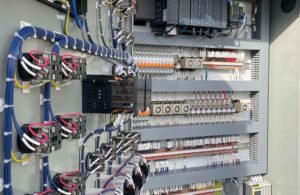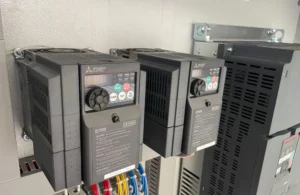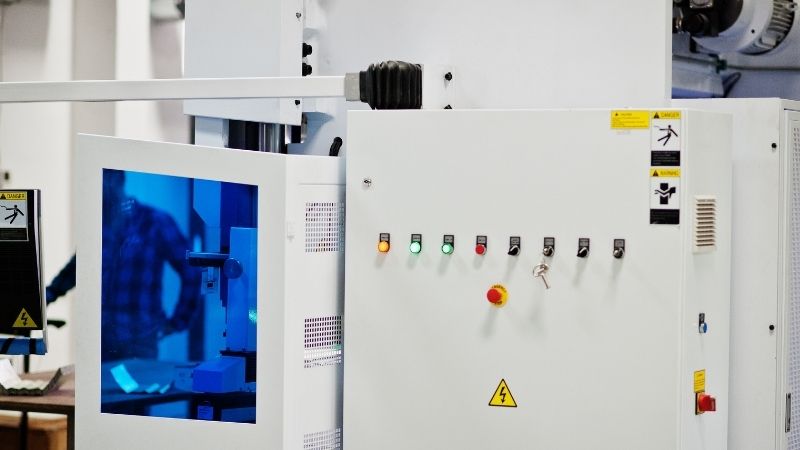RTD és hőelemek: létfontosságú érzékelők az ipari automatizáláshoz
Akár tapasztalt technikus, akár újonc a területen, ezen érzékelők funkcióinak, előnyeinek és alkalmazásainak ismerete javítja a hatékony hőmérséklet-felügyeleti megoldások megvalósítását.
Tartalomjegyzék
Mi az a KTF és hogyan működik?
Az ellenálláshőmérséklet-érzékelők (RTD) precízek érzékelők hőmérséklet mérésére használják az RTD elem ellenállásának a hőmérséklettel való korrelációjával. A jellemzően tiszta platinából, nikkelből vagy rézből készült RTD nagy pontosságot és stabilitást kínál, így nélkülözhetetlenek a különféle ipari alkalmazásokban.
Hogyan méri az RTD a hőmérsékletet
Az RTD azon az elven működik, hogy bizonyos fémek elektromos ellenállása előre láthatóan változik a hőmérséklettel. A hőmérséklet növekedésével az RTD elem ellenállása is nő. Ezt a változást a rendszer méri és hőmérséklet-leolvasássá alakítja át, gyakran a PLC bemeneti kártya vagy más hőmérséklet-figyelő rendszer.
RTD konfigurációk típusai
Az RTD különböző huzalkonfigurációkban kapható – 2 vezetékes, 3 vezetékes és 4 vezetékes –, amelyek mindegyike különböző szintű pontosságot és a vezeték ellenállásának kompenzációját kínálja. A 3 vezetékes RTD-t általában ipari környezetben használják, mivel jó egyensúlyt biztosít a komplexitás és a pontosság között.
Hogyan hasonlítható össze az RTD a hőelemekkel a hőmérsékletmérésben?
Ami a hőmérséklet-érzékelést illeti, az RTD és a hőelemek a két elsődleges versenyző. A különbségek megértése kulcsfontosságú az alkalmazáshoz megfelelő érzékelő kiválasztásához.
Pontosság és stabilitás
Az RTD a hőelemekhez képest kiváló pontosságukról és hosszú távú stabilitásukról híres. Általában ±0,1°C tűréshatárt kínálnak, így ideálisak a precíz hőmérséklet-szabályozást igénylő alkalmazásokhoz.
Hőmérséklet tartomány
Míg az RTD széles hőmérséklet-tartományban kiváló, a hőelemek kiválóan alkalmasak rendkívül magas vagy alacsony hőmérsékletek mérésére, gyakran az RTD által kezelhető tartományon túl. Például a K típusú hőelemek 1800 °C-ig képesek mérni a hőmérsékletet, míg az RTD általában 850 °C körülire korlátozódik.
Válaszidő
A hőelemek egyszerűbb felépítésüknek köszönhetően általában gyorsabb reakcióidővel rendelkeznek, így alkalmasak olyan dinamikus folyamatokra, ahol a gyors hőmérsékletváltozásokat gyorsan kell észlelni.
Milyen tényezők befolyásolják az RTD érzékelők toleranciáját?
Az RTD érzékelő tűrése a hőmérséklet mérésének pontosságára és megbízhatóságára vonatkozik. Számos tényező befolyásolhatja az RTD tűréshatárát, biztosítva a pontos hőmérséklet-felügyeletet.
Anyagminőség
Az RTD elem, gyakran platina tisztasága jelentősen befolyásolja a toleranciáját. A nagy tisztaságú anyagok kiszámíthatóbb ellenállásváltozást mutatnak a hőmérséklettel, ami növeli a pontosságot.
Kalibráció
A rendszeres kalibráció biztosítja, hogy az RTD érzékelők idővel megőrizzék pontosságukat. A kalibrálás során össze kell hasonlítani az RTD leolvasásait az ismert hőmérsékleti szabványokkal, és szükség szerint módosítani kell.
Környezeti feltételek
Az olyan tényezők, mint az elektromos zaj, rezgések és a környezeti hőmérséklet befolyásolhatják az RTD teljesítményt. A megfelelő árnyékolás és telepítés segít enyhíteni ezeket a hatásokat, fenntartva az érzékelő toleranciáját.
Milyen szerepet játszanak a vezetékek az RTD érzékelő teljesítményében?
Az RTD érzékelő bekötése döntő szerepet játszik a pontos hőmérsékletmérés biztosításában. A vezetékek száma és minősége befolyásolhatja az érzékelő teljesítményét és megbízhatóságát.
Vezeték konfigurációja
Az RTD 2 vezetékes, 3 vezetékes és 4 vezetékes konfigurációkban kapható:
- A 2-Wire RTD a legegyszerűbb, de érzékenyebb a vezeték-ellenállás miatti hibákra.
- A 3-Wire RTD jobb kompenzációt kínál az ólomhuzal ellenállásához, és nagyobb pontosságot biztosít.
- A 4 vezetékes RTD a legnagyobb pontosságot nyújtja azáltal, hogy teljesen kiküszöböli a vezeték ellenállását a mérésből.
Huzal anyaga és minősége
A kiváló minőségű platinahuzalok minimális ellenállás-változást biztosítanak, függetlenül a hőmérséklet-ingadozásoktól. Ezenkívül a vezetékek megfelelő árnyékolása megakadályozhatja, hogy az elektromos zaj befolyásolja az érzékelő leolvasását.
Telepítési gyakorlatok
A megfelelő telepítés, beleértve a termikus kutak használatát, megvédheti az RTD érzékelőt a környezeti tényezőktől és a mechanikai igénybevételtől, megőrizve a vezetékcsatlakozások integritását és az érzékelő általános teljesítményét.
Hogyan integrálódnak a PLC-k az RTD-érzékelőkkel az ipari automatizálásban?
Programozható logikai vezérlők (PLC-k) A modern ipari automatizálási rendszerek szerves részét képezik, és az RTD érzékelőkkel való zökkenőmentes integrációjuk elengedhetetlen a hatékony hőmérséklet-felügyelethez és -szabályozáshoz.
RTD-k csatlakoztatása PLC-ekhez
Az RTD érzékelők a PLC-khez csatlakoznak bemeneti kártyákon keresztül, amelyek célja, hogy az RTD ellenállásváltozásait értelmes hőmérsékleti adatokká értelmezzék. Ezek a bemeneti modulok gyakran analóg bemeneti képességekkel rendelkeznek a hőmérsékletmérés folyamatos jellegének kezelésére.
Adatfeldolgozás és -ellenőrzés
A csatlakozást követően a PLC feldolgozza a hőmérsékleti adatokat, hogy valós idejű döntéseket hozzon. Például, ha a hőmérséklet meghaladja a beállított értéket, a PLC olyan műveleteket indíthat el, mint például a hűtőrendszerek aktiválása vagy a motor fordulatszámának beállítása az optimális feltételek fenntartásához.
A rendszer megbízhatóságának növelése
Az RTD és a PLC integrálása kifinomult felügyeleti és vezérlési stratégiákat tesz lehetővé, növelve az ipari folyamatok általános megbízhatóságát és hatékonyságát. Ezenkívül a PLC-k naplózhatják a hőmérsékleti adatokat kalibrálási és prediktív karbantartási célokra, csökkentve az állásidőt és a működési költségeket.
Gyakran Ismételt Kérdések
Mi az elsődleges előnye az RTD használatának a hőelemhez képest?
Az RTD nagyobb pontosságot és jobb hosszú távú stabilitást kínál a hőelemekhez képest, így ideálisak a precíz hőmérsékletmérést igénylő alkalmazásokhoz.
Hogyan befolyásolja a vezeték konfigurációja az RTD teljesítményt?
A vezeték konfigurációja (2-vezetékes, 3-vezetékes vagy 4-vezetékes) befolyásolja a hőmérséklet-leolvasások pontosságát azáltal, hogy kompenzálja a vezeték ellenállását. Több vezeték általában jobb pontosságot biztosít.
Az RTD-k képesek-e rendkívül magas hőmérsékletet mérni, mint a hőelemek?
Az RTD-k hőmérséklet-tartománya korlátozottabb, mint a hőelemeknél. Míg a legtöbb ipari alkalmazásra alkalmasak, a hőelemek előnyösek nagyon magas vagy alacsony hőmérséklet mérésére.
Milyen gyakran kell az RTD érzékelőket kalibrálni?
A pontosság megőrzése érdekében rendszeres kalibrálás javasolt, általában évente, vagy a gyártó vagy az ipari szabványok által előírtak szerint.
Erősítse meg projektjeit vadonatúj, eredeti Omron, Mitsubishi, Schneider PLC segítségével – raktáron, készen áll!
Következtetés
- Az RTD-k rendkívül pontos és stabil hőmérséklet-érzékelők, amelyek ideálisak a precíz ipari alkalmazásokhoz.
- A hőelemek szélesebb hőmérséklet-tartományt és gyorsabb reakcióidőt kínálnak, de kevésbé pontosak, mint az RTD-k.
- A vezetékek konfigurációja (2 vezetékes, 3 vezetékes, 4 vezetékes) jelentős szerepet játszik az RTD mérések pontosságában.
- A PLC-k zökkenőmentesen integrálhatók az RTD-érzékelőkkel, lehetővé téve a kifinomult hőmérséklet-felügyeletet és -szabályozást az automatizálási rendszerekben.
- A rendszeres kalibrálás és a megfelelő telepítési gyakorlat elengedhetetlen az RTD érzékelők pontosságának és megbízhatóságának fenntartásához.
Az RTD-k és hőelemek funkcióinak és alkalmazásainak megértésével az ipari automatizálási szektor szakemberei megalapozott döntéseket hozhatnak hőmérséklet-ellenőrző rendszereik fejlesztése érdekében, biztosítva működésük hatékonyságát és megbízhatóságát.
Új, eredeti PLC-ket keres projektjeihez? A Kwoco-nál a legfrissebb PLC-ket kínáljuk olyan legnépszerűbb márkáktól, mint például Omron, Mitsubishi, és Schneider. Vásároljon bizalommal – gyors szállítás, garantált minőség! Vásároljon most
Lépjen kapcsolatba velünk
Csak töltse ki nevét, e-mail címét és kérésének rövid leírását ezen az űrlapon. 24 órán belül felvesszük Önnel a kapcsolatot.
Ezeket a témákat is érdekesnek találhatja

Az időzítő kapcsoló működési módjának elsajátítása: Átfogó útmutató
Ez a cikk az időzítő kapcsolók bonyodalmaival foglalkozik, és átfogó képet ad különféle típusairól, üzemmódjairól és alkalmazásaikról. Függetlenül attól, hogy Ön gép- és berendezésgyár mérnöke, gyártója vagy egy gyári megoldásokat gyártó cég tagja, ez az útmutató értékes betekintést nyújt abba, hogy az időzítő kapcsolók hogyan javíthatják az ipari automatizálási folyamatokat.

Digitális vs analóg szervók: melyik a jobb az RC motorhoz?
Ez a cikk a szervotechnológia bonyodalmaival foglalkozik, különös tekintettel a digitális és az analóg szervók közötti vitára az RC-motorok területén. Legyen szó gépberendezés-gyártóról vagy ipari vezérlési megoldásokkal foglalkozó cégről, a szervoműködés árnyalatainak megértése elengedhetetlen a gyártóüzemeken belüli automatizálási vezérlés teljesítményének és hatékonyságának optimalizálásához. Ez az olvasmány megadja azokat az ismereteket, amelyek ahhoz szükségesek, hogy megalapozott döntést hozhassanak arról, hogy melyik szervotípus felel meg leginkább az Ön igényeinek, végső soron termékkínálatát és megoldásait bővítve.

10 gyakori Mitsubishi szervo riasztási kód és megoldás: A hibaelhárítás egyszerűen!
10 gyakori Mitsubishi szervo riasztási kód és megoldás: A hibaelhárítás egyszerű! Az ipari automatizálásban a szervohajtások kritikusak, és a Mitsubishi






